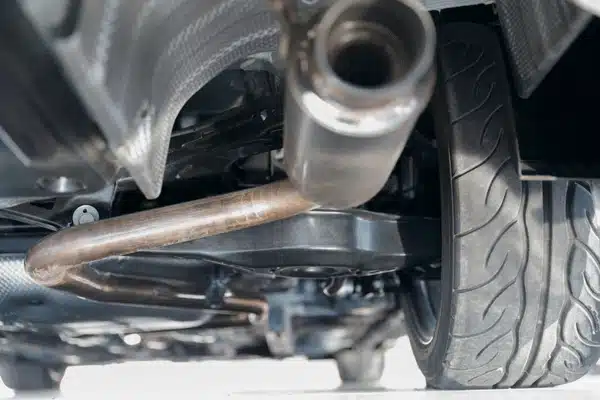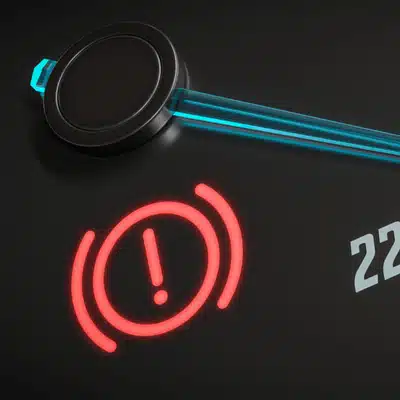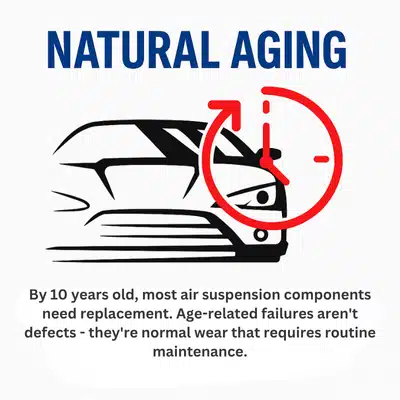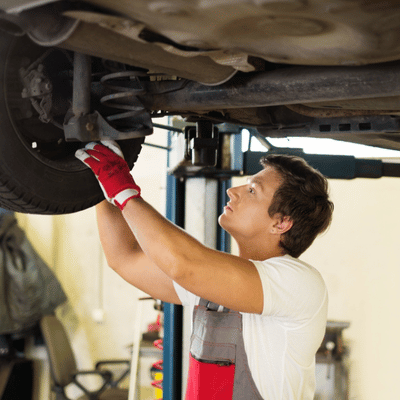Weekdays 8:00am-5:00pm Sat Closed Sun Closed

Your Land Rover delivers that signature smooth ride through advanced air suspension technology. But when problems strike, that comfortable ride can turn rough fast. Air suspension issues affect thousands of Land Rover owners each year, from minor leaks to complete system failures.
This guide covers the most common Land Rover air suspension problems you'll face in 2025. We'll show you signs to watch for, what causes these issues, and how to keep your suspension running smoothly for years to come.
Your Land Rover uses air springs instead of traditional coil springs. Each corner has an air bag that inflates or deflates to adjust your vehicle's height. An onboard computer controls the whole system through sensors at each wheel.
The air compressor supplies pressure to all four corners. When you select different terrain modes, the system raises or lowers your vehicle automatically. This gives you ground clearance for rough terrain and better aerodynamics on highways.
The control module monitors your suspension 500 times per second. It adjusts damping to prevent body roll during turns while keeping your ride smooth on straight roads. This complex system works great when healthy, but multiple components can fail.
Range Rover air suspension issues typically show up in predictable ways. Here are the most frequent problems Range Rover owners face:

Air leaks cause most Range Rover suspension problems. The rubber springs in a Range Rover air suspension system crack at fold points. A tiny breach in the rover air suspension break pathway lets air escape, so the air struts struggle to keep up. Even a slow leak drives the Range Rover air suspension compressor, setting off a warning light.
Minor seepage soon demands costly air suspension repairs on the Range Rover air suspension and components, including a second set of air struts. Range Rover owners who explore custom vehicles or browse featured vehicles want that smooth and comfortable ride Range Rover offers. Review tables like table undo redo drafts and maintain each Range Rover to avoid full rover air suspension failure.
Your air compressor works harder when leaks develop in the rover suspension system. Extended run times cause overheating and motor burnout. A healthy compressor in any car should cycle briefly to maintain pressure. If yours runs for minutes at a time, an error message or front end drop can signal the rover suspension is struggling. Many forum members note moisture and dirt also damage compressors, urging drivers to check the air intake filter on every car. A clogged filter forces the rover suspension compressor to work harder and fail sooner.
When contamination persists, the alignment list recommends you replace the filter and sometimes replace the entire rover suspension dryer. Browse related threads, bb code tips, and the image gallery for aftermarket parts suggestions that keep your car on the ground.
Each corner has a height sensor that tells the control module your vehicle's position. These sensors can fail or give false readings. When this happens, a corner might sit too high or low compared to others.
Sensor wiring gets exposed to water and road salt. Corrosion at connections causes intermittent faults. Off-road adventures can knock sensors out of calibration too.
The valve block in a Range Rover suspension distributes air pressure to each air spring, balancing all four air struts on the car. Internal seals can fail and create unequal flow, so one corner of the Range Rover suspension may sag overnight while the rest of the car seems level. Many drivers notice the front or rear of the Range Rover drop first, a clue the rover suspension is leaking and needs air suspension repairs rather than ordinary tire alignment. Keeping the car parked on flat ground can slow the loss and protect modern Range Rover models.
Although this piece fails less often than springs or compressors, replacing the valve block on a Range Rover suspension usually costs more because the part is intricate and few aftermarket parts exist. Range Rover owners sometimes replace the entire unit to keep the car safe, and a trusted shop will test the car thoroughly before release, sparing the car larger bills.
Suspension bushings connect various components and absorb vibrations. Texas heat accelerates rubber deterioration. Worn bushings create play in the suspension system and can trigger fault codes.
Bad bushings make clunking noises over bumps. They also allow excessive movement that confuses height sensors. This creates a cascade of problems across your air suspension system.
Your Land Rover tells you when suspension problems develop. Watch for these warning signs:

The first sign is usually a suspension issue message on your dashboard. This amber indicator means the system detected abnormal readings. Don't ignore this warning, even if your vehicle still feels normal.
The message might say "Suspension fault - vehicle height may be limited" or similar. Your Range Rover is telling you to get professional care before small problems become big ones.
If one corner sits lower than others, especially after parking overnight, you have an air loss. A healthy air suspension keeps your vehicle level when parked. Sagging corners mean air is bleeding out somewhere.
This often starts subtle but gets worse daily. Don't brush off a slight lean. One side lower than the rest indicates suspension issues that need immediate attention.
Your Land Rover should raise from access height to normal position in seconds. If the suspension takes too long to pump up or you hear the compressor running constantly, something's wrong.
Long compressor run times suggest the system struggles to build air pressure. This usually means an air loss or weak compressor. Healthy systems lift the vehicle quickly and quietly.
Air suspension problems change how your Range Rover feels. If your smooth ride becomes harsh over bumps, the springs might not inflate properly. Worn shock absorbers also cause bouncy, unstable handling.
Try the bounce test on each corner. Push down firmly and release. The vehicle should rebound once and settle. Multiple bounces mean that corner's shock needs replacement.
Listen for new sounds when driving over bumps. Clunking or knocking often indicates worn suspension bushings or ball joints. Hissing sounds near wheels suggest air loss from springs or fittings.
Any new noise from your suspension deserves investigation. Worn components not only make noise but can trigger warning lights as they allow excessive play.
Understanding why Range Rover air suspension problems occur helps you prevent them:

Air springs use heavy-duty rubber that deteriorates over time. Heat, UV exposure, and constant flexing cause cracks after 6-8 years or 60,000+ miles. Rubber seals and bushings also harden with age.
By 10 years old, most air suspension components need replacement. Age-related failures aren't defects - they're normal wear that requires routine maintenance.
Texas heat accelerates rubber deterioration. Extreme temperatures and UV exposure dry out springs faster than in mild climates. Road salt and chemicals also attack rubber components.
Construction zones and poor roads stress suspension components daily. Sharp debris can puncture air cushions. Frequent impacts from potholes wear out shocks and bushings prematurely.
Carrying too much weight or exceeding towing capacity damages air suspension components. Heavy loads make springs work harder and fail sooner. Aggressive off-roading can damage airlines.
Stay within your vehicle's weight ratings. Use common sense on rough terrain. Abuse shortens component life significantly.
Small problems multiply when ignored. A minor air leak makes the compressor work harder, leading to motor failure. Dirty air filters contaminate the compressor. Worn bushings stress other suspension components.
Regular maintenance catches issues early when repairs cost less. Neglect turns minor issues into major failures.
Keep your Range Rover air suspension healthy with these maintenance practices:
Have your suspension checked annually or every 12,000 miles. Professional inspections catch problems early using diagnostic tools you can't access. Technicians spray soapy water on springs to spot leaks and scan for fault codes.
Don't wait for obvious symptoms. A 30-minute inspection could save you from roadside breakdowns and expensive repairs.
Mud and road salt damage suspension components. Rinse your undercarriage after off-road adventures or winter driving. Clean sensors and linkages so they move freely.
Check the air compressor intake for debris. A clean intake prevents contamination that damages internal components. Regular cleaning extends component life significantly.
Air springs and bushings have predictable lifespans. Replace springs around 8-10 years or 80,000 miles before they fail unexpectedly. Worn bushings should be renewed by 80,000 miles to prevent cascade failures.
Proactive replacement costs less than emergency repairs. You choose when and where to do the work instead of dealing with sudden failures.
Land Rover releases software updates for suspension control modules. These updates improve performance and fix known issues. Have your independent mechanic check for available updates during service.
Current software ensures your suspension runs with all factory improvements. This simple step prevents many problems without hardware changes.
OEM parts match your Land Rover's exact specifications. Cheap aftermarket components often fail prematurely and can cause compatibility issues. Quality parts maintain your suspension's performance and reliability.
An experienced Land Rover mechanic can recommend trusted aftermarket brands if you want to save money. But avoid bargain parts that compromise safety and performance.

Air suspension systems require specialized knowledge and tools. Choose an independent mechanic who specializes in Land Rover vehicles. They have the diagnostic equipment to read suspension fault codes and calibrate components properly.
Generic shops often lack the tools to properly diagnose Range Rover suspension issues. Land Rover-specific scanners can command individual corners to raise and lower for testing. This precision saves time and money by targeting the real problem.
Experienced technicians know common failure patterns and best repair practices. They understand how components interact and can prevent cascade failures. Proper calibration after repairs ensures everything works together correctly.
Your Land Rover represents a significant investment in luxury and capability. Proper suspension maintenance protects that investment and ensures years of smooth, comfy rides.
Address problems early before they multiply. Small repairs cost far less than major overhauls. Stick to a regular maintenance schedule and use quality parts. Your reward is the comfy ride and confidence-inspiring handling that defines the Land Rover experience.
Don't wait for suspension problems to strand you. If your Land Rover shows any signs or hasn't had a suspension inspection recently, schedule professional service now. Early detection and repair prevent expensive cascade failures and keep you on the road.
Contact us today for a comprehensive suspension inspection. Your smooth ride depends on it.


